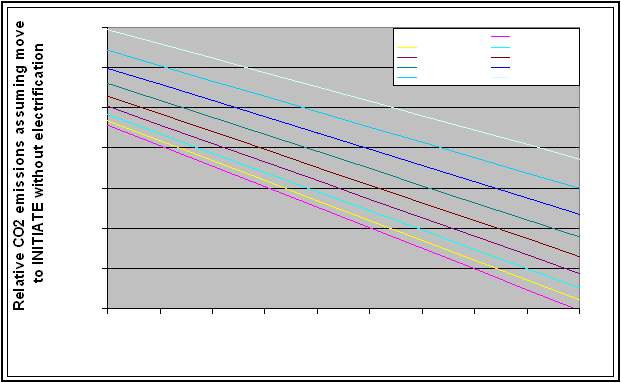
0.9
0.92
0.94
0.96
0.98
1
1.02
1.04
5
10
15
20
25
30
35
40
45
50
% Road Freight moved to multiple trailers
% rail freight*
10
15
20
25
30
35
40
45
50
Figure 31 Relative CO2 emissions changing from heavy Road Freight and rail to the
INITIATE system without electrification
Over the longer term, the use of a guided network for heavy vehicles would facilitate their conversion to an
electric mode of propulsion by allowing their batteries to be charged whilst on the network, then releasing this
stored battery power after leaving it for driving on the road. INITIATE may also facilitate unobstructed driving
through urban areas, which is particularly useful for buses and smaller urban delivery vehicles and this could
convey a substantial CO2 advantage well in excess of that implied in figure 31.
Ultimately, however
electrification of the heavy transport sector is the main advantage of INITIATE and this provides the
potential to power them from a wide range of zero or low carbon sources.
6.2.3
Using hybrid steel/pneumatic tyres for trains
Steel tyred conventional trains could be retained using dedicated lines for delivering bulk loads such as coal
between large suppliers and users, or for high-speed passenger services. However, allocating enough of the rail
network for INITIATE would be problematic in countries that transport a significant amount of freight by
means of conventional steel tyred trains. A potential solution is to equip trains with hybrid rail-road wheels
which consist of both steel tyres which are used on rails, and integral pneumatic tyres with a slightly increased
diameter than the steel ones which are used on the road.
Over most of a long journey, the vehicles would use steel tyres on steel rails as with present day railway rolling
stock; this would provide lower rolling resistance than when using pneumatic tyres. However, as the vehicles
advance towards a junction, the road surface would rise so the clearance of the rail over the supporting ground
decreases until the pneumatic tyres makes contact with the ground. This allows the train to drive on a road
surface so they can be steered onto the appropriate track, using similar tapered guides to that already described.
The front propulsion unit could be steered at the junctions by differential speed on either side of the vehicle to
reduce the necessity of introducing a fully steerable unit.
Once on the correct track, the road height would drop increasing the rail clearance until the steel tyre makes
contact with rail again and the pneumatic tyres are lifted clear (See figure 32).
The ‘road’ surface at the
junctions or transfer points would be similar to present day level crossings. The same arrangement can also be
used to provide entry and exit points to the road infrastructure, so the vehicles can move directly on and off the
road onto the track without stopping as with INITIATE.
The use of a road surface at the junctions allows the removal of unreliable points and frogs (where opposing
lines cross and nearly touch) and allow rails fixed on the track guides to be charged with opposite polarity for a

